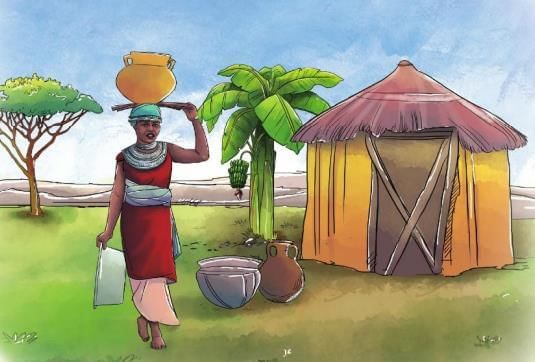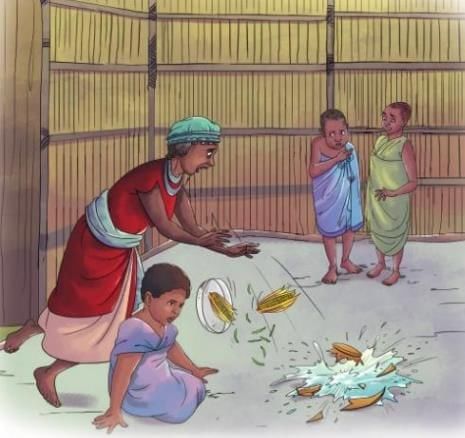The Calabash Kids Chapter Notes | English Class 4 ICSE PDF Download
| Table of contents |

|
| Introduction |

|
| Key Points |

|
| Explanation |

|
| Message |

|
Introduction
The story "The Calabash Kids" is a fun tale from Tanzania about a lonely woman named Shindo. She lives alone after her husband passes away and has no children to help her with daily tasks. Feeling tired and sad, she prays for help. A magical event happens when she plants special gourd seeds given by a messenger from the Great Mountain Spirit. These gourds turn into children who help her with her work. The story teaches us about kindness, love, and being careful with our words.
Key Points
This story is about Shindo, a lonely woman whose husband had died.
- It tells how she prays to the Great Mountain Spirit for help with her daily chores.
- It describes a noble chieftain, a messenger, who gives her special gourd seeds as an answer to her prayers.
- It shows how the gourds grow quickly and turn into children who help Shindo with her work.
- It explains that one child, Kitete, is slow because he dried by the fire, unlike the other children.
- It shares how Shindo accidentally turns Kitete back into a gourd by scolding him harshly.
- It highlights how the other children help bring Kitete back, and Shindo learns to be kind and careful with her words.
Explanation
Shindo lives in a quiet village at the foot of a snowy mountain. After her husband passes away, she has no children to keep her company, which makes her feel very lonely. Every day, she works hard by herself, doing tasks like cleaning her hut and yard, taking care of chickens, washing clothes by the river, carrying water, cutting firewood, and cooking her meals.

Tired from all this work, she looks up at the mountain every evening and prays to the Great Mountain Spirit for help. One day, while she is weeding her small field where she grows vegetables, bananas, and gourds, a noble chieftain appears. He is a messenger from the Great Mountain Spirit and gives her some special gourd seeds, telling her they will answer her prayers.
Though she is surprised and unsure how seeds can help, she plants them carefully. To her amazement, the seeds grow into long vines with ripe gourds in just a week. She brings the gourds home, cuts off their tops, scoops out the insides, and places them on the rafters of her hut to dry. She plans to sell them to make bowls and jugs. One gourd, which she places near the fire to dry faster for her own use, starts a magical change.
The next morning, while she is away tending her field, the gourds transform. They sprout heads, arms, and legs, turning into children. The one by the fire becomes Kitete, who is slow because of the heat, while the others on the rafters are active. These children sing and play, calling Kitete to join them with the lines, "Ki-te-te, come help us! We'll work for our mother. Come help us, Ki-te-te, our favourite brother!"
They quickly do all her chores—cleaning, feeding the chickens, washing clothes, carrying water, cutting firewood, and cooking a meal. When the work is done, they climb back to the rafters and turn into gourds again. Shindo is shocked to find her work done and her meal ready when she returns, and this happens again the next day.
Curious, she hides the following morning and watches the gourds turn into children. When they nearly bump into her, she is too surprised to speak, but they continue their tasks. Seeing this, she decides they should stay as her children. She keeps them, and they help her so much that she soon becomes rich with many fields of vegetables and bananas, and flocks of sheep and goats. All the children are helpful, but Kitete stays by the fire, smiling simply, which Shindo usually enjoys as he feels like a sweet baby.

However, when she is tired or upset, she sometimes scolds him. One day, while cutting vegetables for a stew, she trips over Kitete while carrying a clay pot. The pot breaks, spilling vegetables and water everywhere. In anger, she scolds him and calls him "nothing but a calabash." Instantly, Kitete turns back into a gourd. Regretting her words, she cries out, and the other children climb to the rafters, calling Kitete to return. After a long wait, Kitete slowly changes back into a boy. From then on, Shindo is very careful with her words, and her children bring her happiness and comfort for the rest of her life.
Message
The story teaches us to be kind and thoughtful with our words. Shindo learns that saying harsh things can cause harm, but love and care can make things right again. It also shows how helping each other and having a family can bring joy and success.
New Words with Meanings
- Chore: A boring task that needs to be done every day.
- Gazed: Looked at something steadily for a long time.
- Weeding: Removing unwanted plants from the ground.
- Chieftain: The leader of a tribe.
- Astonished: Very surprised.
- Trailed: Grew along the ground in a long line.
- Rafter: A strong beam that supports a roof.
- Slow-witted: Slow in learning or thinking.
- Astounded: Greatly surprised.
- Shattered: Broke into many small pieces.
- Scampering: Moving quickly with small, light steps.
- Thereafter: From that time onward.
FAQs on The Calabash Kids Chapter Notes - English Class 4 ICSE
| 1. What are the key benefits of Calabash Kids Insurance? |  |
| 2. How can parents choose the right Calabash Kids Insurance plan for their children? |  |
| 3. What are common exclusions in Calabash Kids Insurance policies? |  |
| 4. How does Calabash Kids Insurance handle claims and reimbursements? |  |
| 5. Are there any age limits for enrolling children in Calabash Kids Insurance? |  |














